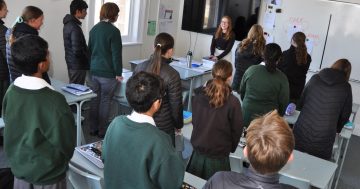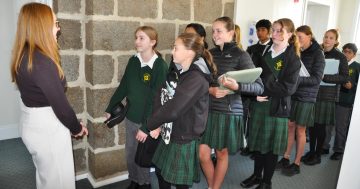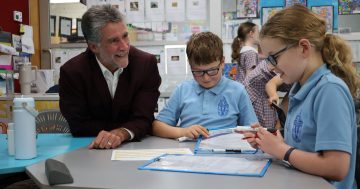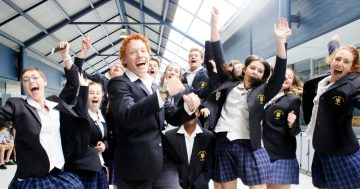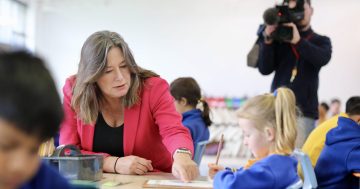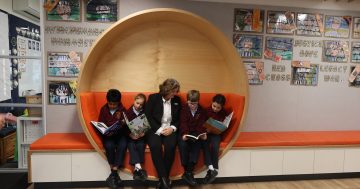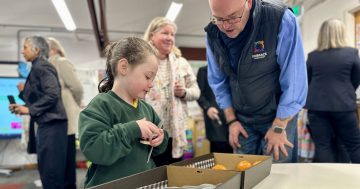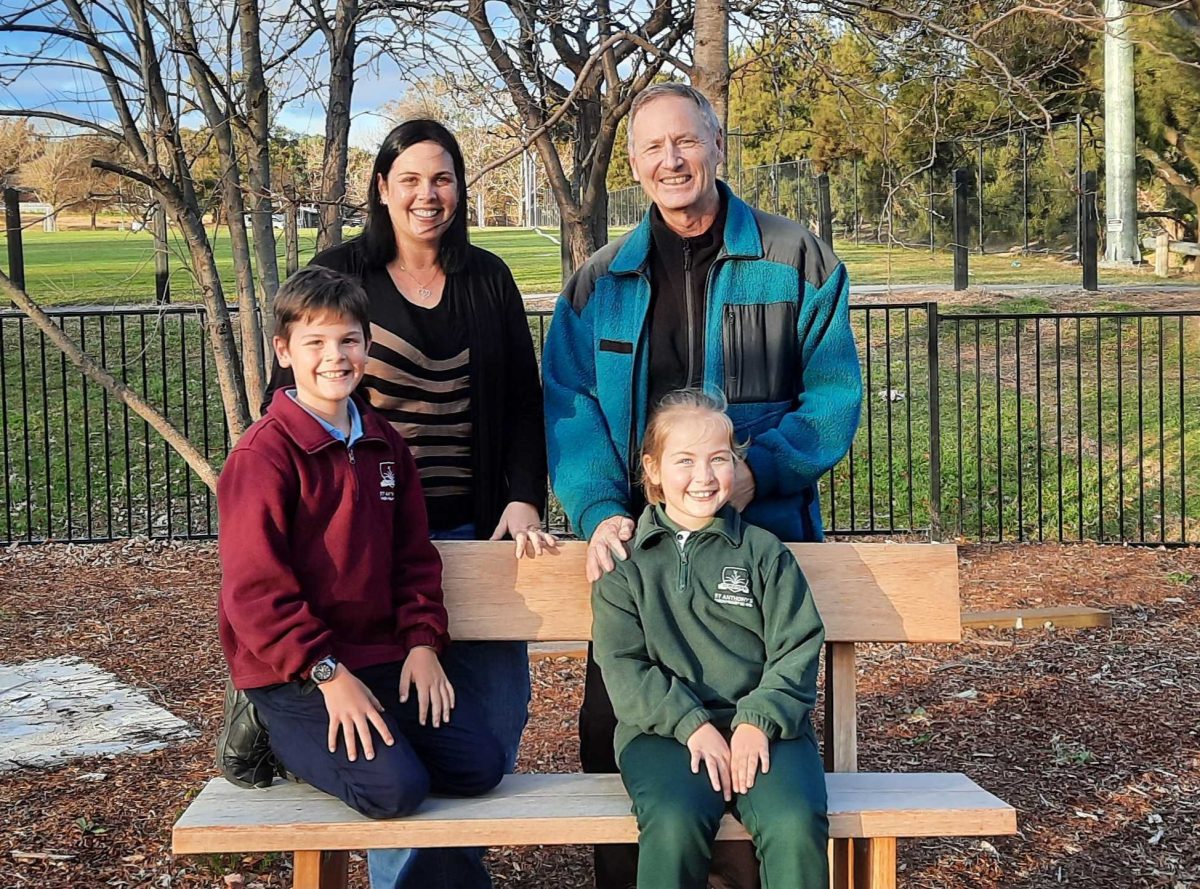
The Wilkins family (clockwise from left): Rachel, Richard, Evie and Nate at St Anthony’s Primary School in Wanniassa. Photo: Ian Bushnell.
Meet the Wilkins family. They are part of the drift away from public education to non-government schools, as revealed in the latest ACT Schools Census.
The census, taken every February, shows a continuing slippage in public school enrolments over the past three years and successive growth in the Independent and Catholic sectors.
While the losses are not large, they do come in the context of concerns about standards and consistency in public schools, highlighted by the Final Report of the Literacy and Numeracy Education Expert Panel the government has pledged and funded to act on.
Those findings were no surprise to Rachel Halls and Richard Wilkins, who took their children Nate, 8, and Evie, 6, out of their local school in the middle of last year and transferred to St Anthony’s Parish Primary School in Wanniassa.
They haven’t looked back.
Evie’s reading struggles are over in Year 1, and Nate is now mastering his numbers in Year 3, as well as enjoying having his own desk.
Rachel said his former school employed a “flexible furniture” approach, which often left Nate without a seat or table to work at.
“We’d get photos home on the Seesaw platform and he’d be wrapped around the table leg, he’d be kneeling at the back,” she said.
“He’s someone that needs a bit of structure. Well, they both need structure, and there was no structure.”
It’s a familiar story of skills and culture for parents who make the switch.
Rachel said Evie wasn’t picking up reading, and Nate’s maths was appalling, but that has all been turned around at St Anthony’s.
It costs the family more in fees and fuel – they live in the same street as the local school but now have to make the run to Wanniassa.
“It was a big thing to us because we could walk the children to school every morning and the children could walk home,” Rachel said.
Richard said it had been give and take.
“That was the choice, but we weren’t getting what we needed,” he said.
They said the public school did not respond to their concerns despite multiple meetings.
Having decided to move, Rachel and Richard looked at various options, public and private, but it was St Anthony’s welcoming, inclusive culture that captured them from the first contact.
“In the other school, we weren’t given many opportunities to come in and see where the children are with their learning,” Rachel said.
“My parents have been in at St Anthony’s and been able to experience assemblies.
“That’s been really great to see where the children are at. Everyone seems to be very friendly and know who the kids are.”
They also thought the teachers were more engaged and committed, and happier.
St Anthony’s is “100 per cent invested” in the Catalyst high-impact teaching program deployed by Canberra and Goulburn Diocese schools and is about to take up the Classroom Mastery behavioural approach as well.
Assistant Principal Gareth Wigg said it was affirming to hear the Wilkins’ story because the hard work behind the scenes around teaching, learning and culture was a big focus for the school.
“That’s something that takes years to build and can be lost within a day or two if things aren’t managed,” he said.
“Some people pump the brakes when things are going well, and we’re looking to go the other way and push down hard on the accelerator.”
That came from leadership, starting with principal Erin Marmont, Mr Wigg said.
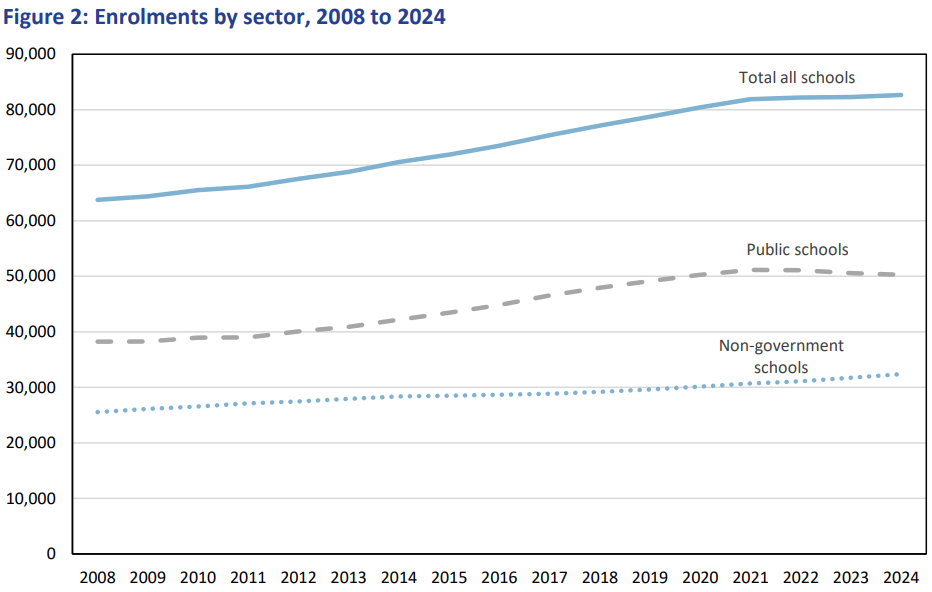
It’s not exactly an exodus from the public system, but enrolments outside government schools are on the rise. Image: ACT Government.
Overall, ACT public schools incurred a decline of 280 students from 2023 to 2024, specifically in pre-school and primary schools.
Enrolments actually increased in high schools and colleges.
From 2021 to 2024, public school enrolments fell from 51,153 to 50,276, with 532 students (-1.0%) departing between 2022 and 2023.
Total Independent school enrolments have risen every year in the same period from 15,390 to 16,769, with growth of 3.7 and 3.4 per cent in 2022 and 2023.
Catholic school enrolments also rose every year, from 15,331 to 15,609.
It’s not an exodus from the public system but a steady trickle, something the Education Directorate was not too concerned about, saying it reflected changing demographics.
A spokesperson said public primary school enrolment numbers reflected the slightly smaller cohorts now tracking through from the early years which were substantially consistent with lower estimated residential populations for those age groups.
“Enrolment figures fluctuate over time and a short-term modest decline in public school enrolments is not cause for concern,” the spokesperson said.
“Similar trends are being reported nationally, particularly given population projections anticipate future growth.
“As suburb demographics go through their cycle, we see fluctuations in enrolment numbers.”
The spokesperson said families made enrolment decisions for a variety of reasons.
Education Minister Yvette Berry echoed that.
“What we’re seeing is families making choices and about what suits their individual needs, and that could include choosing to go to independent schools,” Ms Berry said.
She further noted that the data did not show a trend away from public schools, and she did not accept that their standards had fallen.
She said the literacy and numeracy inquiry had recommended changes based on new research and she had listened to the experts.
“That will be a system of change over four years; there will be some of our schools that will need to go a little bit further, and there will be schools that are already there making that change,” she said.
“It’s a significant one and we know that the community is interested to see how that change will impact on their own children.
“Our schools are excited about the opportunities that have been presented to them, particularly around changes to workload to ensure that they can deliver a great education.”












